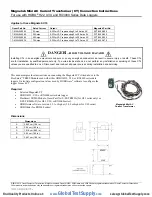
– –
– –
102
103
Pad Layout
The pad layout diagrams below are designed to facilitate both hand and
automated assembly. Figure 109 shows the footprint for the module.
Castellation Version Reference Design
The castellation connection for the antenna on the module allows the
use of embedded antennas as well as removes the cost of a cable
assembly for the u.FL connector. However,
the PCB design and layer
stack must follow specific reference designs for the certification
on the HUM-A-900-PRO-CAS to be valid.
Please see RG-110,
HUM-A-900-PRO PCB Trace Layout Reference Guide, for details on the
PCB requirements
0.063"
0.015"
0.028"
0.070"
0.626"
0.015"
0.063"
0.050"
0.051"
0.070"
0.170"
0.100"
0.162"
Figure 109: HUM-A-***-PRO Recommended PCB Layout
Microstrip Details
A transmission line is a medium whereby RF energy is transferred from
one place to another with minimal loss. This is a critical factor, especially in
high-frequency products like Linx RF modules, because the trace leading
to the module’s antenna can effectively contribute to the length of the
antenna, changing its resonant bandwidth. In order to minimize loss and
detuning, some form of transmission line between the antenna and the
module should be used unless the antenna can be placed very close (<
1
⁄
8
in)
to the module. One common form of transmission line is a coax cable and
another is the microstrip. This term refers to a PCB trace running over a
ground plane that is designed to serve as a transmission line between the
module and the antenna. The width is based on the desired characteristic
impedance of the line, the thickness of the PCB and the dielectric constant
of the board material. For standard 0.062in thick FR-4 board material, the
trace width would be 111 mils. The correct trace width can be calculated
for other widths and materials using the information in Figure 110 and
examples are provided in Figure 111. Software for calculating microstrip
lines is also available on the Linx website.
Trace
Board
Ground plane
Figure 110: Microstrip Formulas
Example Microstrip Calculations
Dielectric Constant
Width / Height
Ratio (W / d)
Effective Dielectric
Constant
Characteristic
Impedance (
Ω
)
4.80
1.8
3.59
50.0
4.00
2.0
3.07
51.0
2.55
3.0
2.12
48.8
Figure 111: Example Microstrip Calculations
Note:
The PCB design and layer stack for the HUM-A-900-PRO-CAS
must follow the reference design for the pre-certification to be valid.
The HUM-900-PRO-CAS must use one of the antennas in Figure 107
in order for the certification to be valid.
All modules require unintentional radiator compliance testing in the end
product as it will go to market.
Содержание EVM-900-PRO
Страница 1: ...HumPRO ATM Series 900MHz RF Transceiver Module Data Guide...
Страница 60: ...114 115 Notes...








































